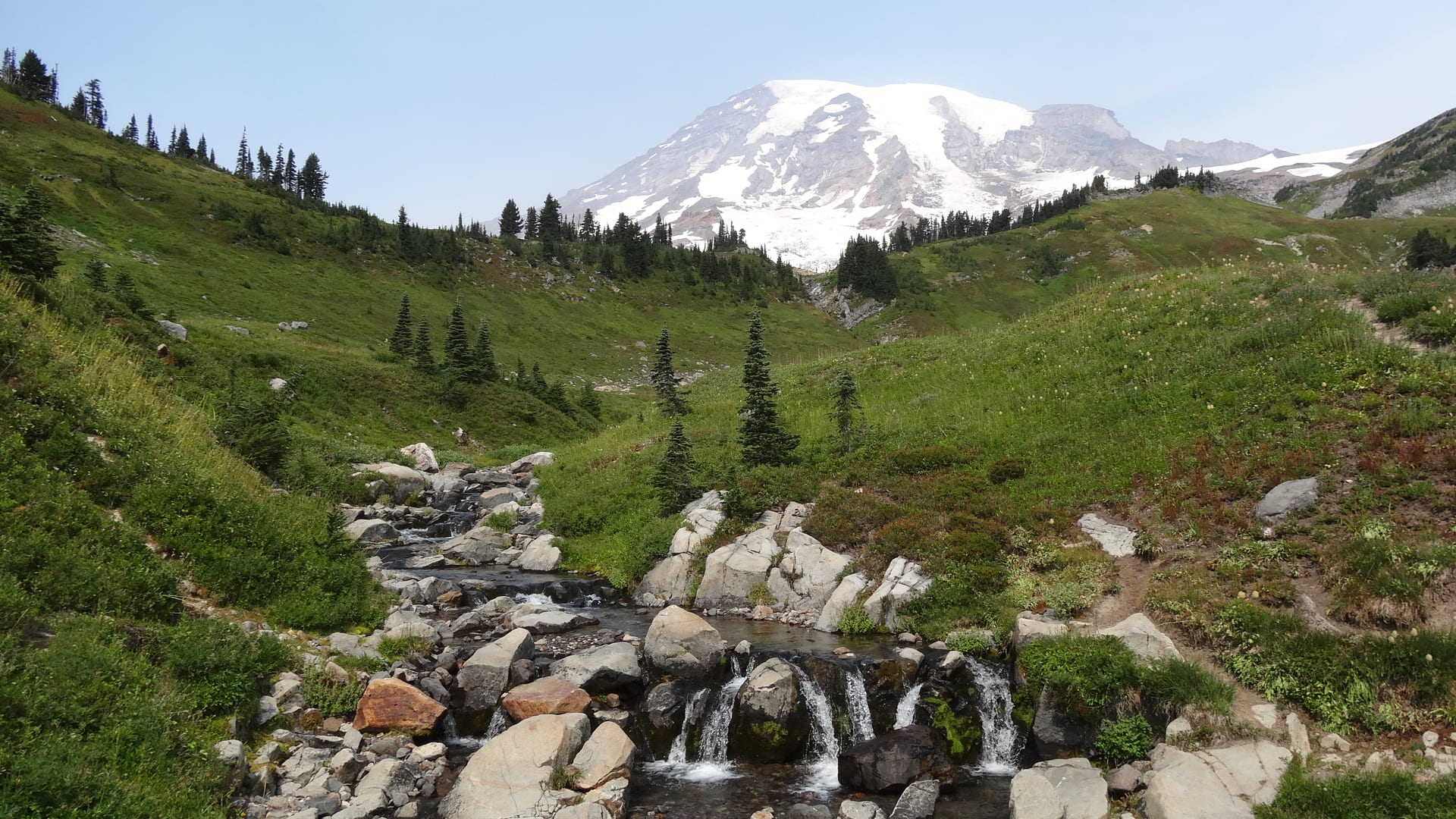So you’ve decided to go hiking. Awesome! But the big question is, what do you bring in your pack for a day hike? These are the top 12 items that I highly recommend bringing with you before you hit the trails.
Things You Should Wear
First Up....Hiking Boots
I see so many people walking on the trails in flip flops or sandals and wonder how they have not hurt themselves. A good pair of hiking boots is the most essential item you should have for hiking. Hiking trails vary from paved concrete, to smooth dirt, to extremely rocky.
Hiking boots can protect your feet not only from dust, but also from cutting your foot on rocks and tree stumps. If you pronate or roll your ankle slightly when walking, a pair of boots that come up to your ankle, will help prevent you from rolling your ankle, especially when walking on uneven surfaces.
Every person’s foot and needs are different so there’s not one type of boot that I particularly recommend. Getting fitted for them correctly is the best recommendation I can give to you. If you go to REI, they will make sure your boots fit properly.
Hiking Socks
Hiking socks go hand in hand with your hiking boots. You want socks that are breathable and moisture wicking. When your feet get sweaty or wet from walking through water, it increases the possibility of getting blisters. Moisture wicking socks help keep your feet dry.
They also act as a barrier between your foot and your boot and keep your foot from moving around too much inside the boot which can also cause blisters. The best material for hiking socks are wool or merino. Hiking socks can either be thin or thick depending on what type of climate you’ll be hiking in.
Hiking Pants
Leggings have become a very popular choice in recent years for hiking. And while they are comfortable (most of the time), they aren’t really that great for hiking. One reason is because they cause more stomach bloating.
Have you ever noticed when you work out, that you seem to get a little bloated in the tummy area? It happens to a lot of us, (especially after 30) but when you’re wearing pants that are skin tight on your lower half, it makes the bloating worse.
And if that wasn’t bad enough, dealing with sweat in leggings is even worse. Try going on a five mile hike in summer with your day pack on and you’ll come face to face with a case of the back sweats. Glamourous? Not so much. But it happens. And back sweat doesn’t just stop with the back. It continues down your backside.
And soon your leggings can become soaked with sweat. Then, when it comes time for a bathroom break, those leggings stick to your skin, and it becomes extremely difficult to get them back up again.
And if all of that isn’t enough to persuade you, leggings and sweat make a bad combination when it comes to your health. Tight fabrics do not allow your skin to breathe very well, and after a long day of hiking, it could put you at a higher risk for a urinary tract infection, especially if you are prone to them.
So while leggings are cute, they’re not exactly the most hiking friendly.
You should opt for lightweight and breathable fabrics when it comes to hiking pants. If you’re going to be hiking in an area that gets a lot of rain, look for pants that are waterproof or water resistant. No one wants to hike in wet pants the rest of the day.
You can also get hiking pants that are convertible, meaning that they can turn into shorts if you get hot while hiking. There are hiking pants that have zippers around the knees that allow you to remove the bottom part of your pants, or ones that have ties and button snaps that allow you to roll up your pants.
If you opt for the ones with the zippers, just remember that you’ll have to carry around the bottom part of your pants in your day pack.

Things To Bring In Your Day Pack
Sunscreen
Sunscreen is a must even if you’re hiking on a cloudy day. You can still get sunburned. And you can still get sunburned even in winter. Did you know that sun that reflects off of snow is almost twice as strong as sun that is directly on you? The glare off of snow amplifies the sun’s rays and can you leave you more sunburned than if you were at the beach.
The amount sunscreen you need depends on what your skin tone currently is. If you have a light or fair complexion, you’ll need a higher SPF factor. If you have more of an olive or dark complexion, you will need less.
And if you’re out all day hiking or you go swimming, you will need to reapply during the day. Sunscreen starts breaking down after a few hours, so make sure to carry this in your day pack so you can reapply as necessary.
Bug Spray
Ever been “eaten alive” by mosquitoes? It’s killer. The aftermath is horrible though. Those suckers can cause so much itching. And if you have any allergies, it could make it much worse. But it’s not just mosquitoes that you have to worry about when hiking.
Several trails in Washington will warn you about hornets and wasps. Some trails are prone to clusters of little gnats. But the biggest pest you should be worried about are ticks.
Yes, they can dig into your skin and suck your blood like little vampires, but they can also carry diseases. Some ticks carry Lyme disease which will stay with you for the rest of your life.
Other ticks may carry Rocky Mountain Spotted Fever which may not have the longevity of Lyme disease, but it can still land you in the hospital.
The easiest way to protect yourself is to use bug spray to repel the little suckers while you’re on the trails. You can purchase bug spray that has DEET in it which will repel bugs.
You can also purchase permethrin spray which you can apply to your clothes and your tent if you’re going camping. Permethrin spray is not to be applied directly to your skin however. Always read the instructions on the bottle to make sure you are applying the spray correctly.

Basic First Aid Kit
You should never hit the trails without some kind of first aid kit. How extensive it needs to be depends on the types of trails you’re going to hike. At the very least, your kit should contain blister pads, band-aids, and antibiotic cream.
Blisters, sunburn, and bug bites are the most common injuries you’ll have to treat while hiking. But if you’re going on trails with a higher difficulty, you may need to take more items in your first aid kit. What else should you take? Read this post to find out.
Water
This should be an obvious one but believe it or not, so many hikers end up dehydrated on their hikes. Dehydration can cause dizziness and lightheadedness. That’s not something you want to risk if you’re hiking up the side of a mountain. Higher temperatures and higher altitudes can increase dehydration. Always overestimate the amount of water you’ll need. It’s better to have too much, than not enough.
Compass
While most trails in the National Parks will be well marked, you never know when you might actually need a compass to find your way back. Many trails merge together in the National Parks and if you happen to miss a trail marker, you could end up off course.
A GPS device can be a great tool, but you will need one that works without a cell signal. If you are able to find a signal in the National Parks, it will most likely be very weak. GPS devices can also malfunction or the batteries could die, leaving you stranded. If you take a GPS device, you should also still bring a compass with you as a backup.

Bear Bell
If you’re going hiking in bear country, a bear bell is a necessity. Bears do not like to be startled. While most black bears do not have an interest in humans, and will not willingly seek them out, they can become aggressive if they are startled.
Imagine if you were just eating dinner and someone snuck up behind your and tapped your back. You would most likely jump! And while no one should ever walk up and try to touch a bear, bears can still get startled if they don’t hear you coming.
The easiest way to avoid this is, by attaching a bear bell to the outside of your day pack. So while you’re hiking, the bell will swing side to side and create a little noise while you’re on the trail.
This will usually be enough to let a bear know that there are humans approaching and most of the times, they will go further into the woods to avoid any interaction. If you want to step it up a notch, you can also talk softly or play music while hiking.
Emergency Shelter and Emergency Blanket
The mountains can be extremely unpredictable. It can be sunny and warm in the morning, and then a sudden storm can rage through in the afternoon. And while you should always check the weather in the morning before you venture on the trails, the weather report might not always be accurate.
If you’re going on shorter hikes (1-3 miles), you might be able to make it safely back to the trailhead if inclement weather should come up. But if you’re on longer trails (such as the 14-mile High Line trail at Glacier National Park), you might not be able to make it back if a storm suddenly rolls in.
Portable emergency shelters are small enough to put in your day pack, and can be thrown up quickly. Simply pull them out of their bag and they will pop open. (It’ll be harder getting it back in the bag than it will be putting it up.)
It will keep you dry while a storm passes through. I purchased this survival tent for less than $20.
If you’re hiking in an area known for big temperature swings, an emergency blanket is also a must have. They are small and foldable like ponchos and look like sheets of tinfoil but don’t let that fool you! They really do their job of keeping you warm if temperatures start dropping.
Combine that with your emergency shelter, and you should be able to stay warm and dry.

Whistle
A whistle is one of the most important safety devices you can carry. Whistles should only be blown if you are in distress.
For example, if you have injured yourself and can not make it back to the trailhead on your own, you should blow your whistle to alert other hikers that you are in need of help. Always keep your whistle somewhere that it is easily accessible such as around your neck or attached to the outside of your day pack.
To alert others, blow on the whistle three times. Each blast should be 3 seconds long with a short pause before the next one. Repeat this series once per minute until help arrives.
Now You Have Your Basics!
No matter where you’re hiking or what the trail difficulty is, you should always be prepared and carry the basic necessities. Once you have all your essentials in your day pack, you will be ready to go off and have some amazing adventures. Happy Hiking!









Pingback: Hiking Etiquette For Beginners — Lynn Blakley